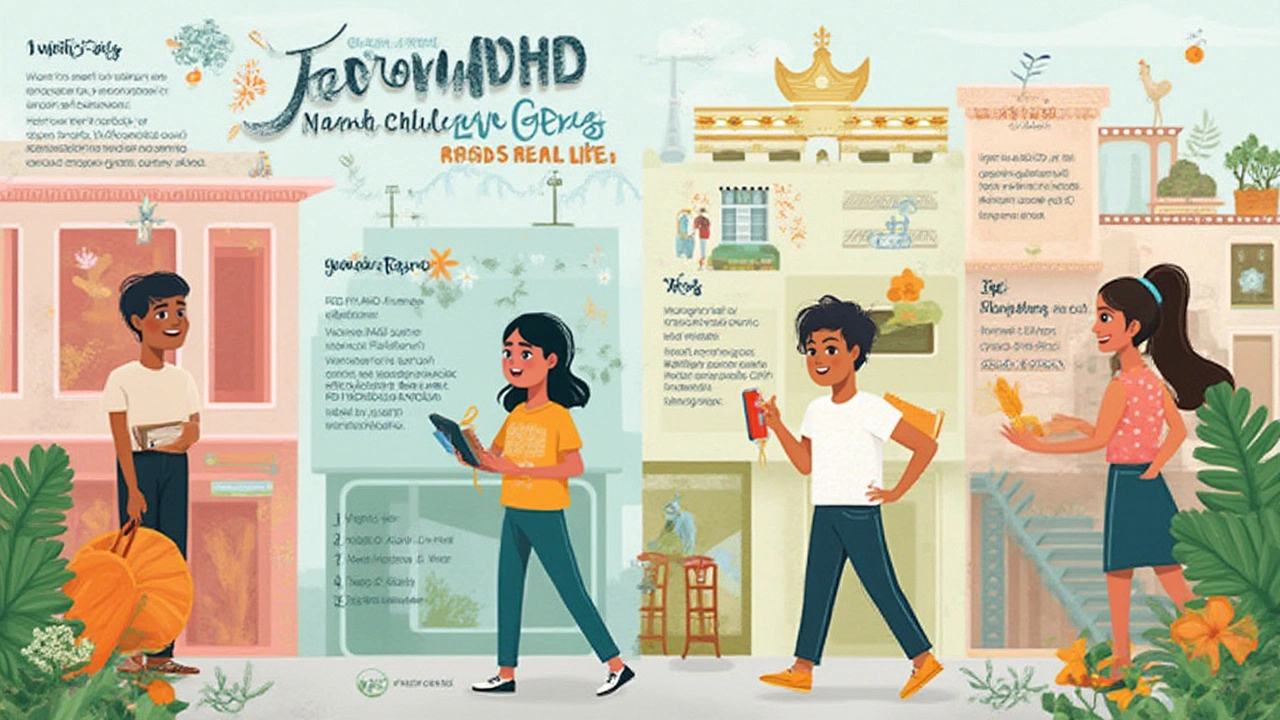Most people think of kids who can't sit still when they hear “ADHD.” But there’s more going on under the hood. Imagine trying to focus when your mind’s got the same energy as a bag of bouncing kangaroos—and half those kangaroos run off chasing shiny things. That’s living with ADHD. It’s not about laziness, lack of willpower, or being wild. The three legs of ADHD—Inattentiveness, Hyperactivity, and Impulsivity—work together, tripping people up in ways that can surprise even those closest to them.
The Building Blocks: What Are the Three Legs of ADHD?
When doctors talk about ADHD (Attention Deficit Hyperactivity Disorder), they don’t mean just one thing. They look for three main signs, the so-called “legs” that hold up the diagnosis: inattentiveness, hyperactivity, and impulsivity. If you pull any one of these legs, life gets wobbly. Inattentiveness looks like missed details and jobs half-finished, but it’s not that someone isn’t trying. It’s like their brain just slips gears sometimes, jumping tracks mid-sentence or mid-task.
Hyperactivity, the second leg, gets all the press. This is the fidgeting, the tapping, the up-and-down energy that people notice across a schoolroom or a workplace. But—and here’s the kicker—hyperactivity doesn’t always mean bouncing off the walls. Adults, especially, may just feel restless or find themselves constantly moving inside their head, replaying thoughts and ideas.
The third leg, impulsivity, gets people into trouble. Impulsive folks with ADHD speak before they think, blow money on a whim, blurt out answers or feelings, and sometimes dive into action before pausing to work out the plan. These three legs can come in different strengths. Some people trip the most over distractibility; others, like my mate Dave from footy, say it’s always their mouth running ahead of their mind.
If you peek at the history, the medical community’s been tossing around these symptoms for more than a hundred years. Researchers even described “fidgety Philip” in kids as early as the 1800s. Today, the three symptoms guide not only diagnosis but also the types of treatment and support folks get. For example, stimulant meds mainly help with inattentiveness and hyperactivity. School strategies, like movement breaks, focus on helping kids channel their need to move. And practical coaching helps manage poor impulse control.
Here’s something else that’s eye-opening: many adults only spot their own ADHD after seeing it in their kids. When doctors diagnose, they check for at least six signs from two of these legs showing up in more than one area of life, like work and home. No matter the age, those three legs stand at the center of understanding what ADHD really means.
| Symptom | Common Behaviors | Example Scenario |
|---|---|---|
| Inattentiveness | Distracted, forgetful, disorganized | Forgets appointments, loses keys |
| Hyperactivity | Fidgety, restless, talks excessively | Taps foot constantly during meetings |
| Impulsivity | Interrupts, can't wait turn, risky decisions | Blurts out answers, drives recklessly |
Inattentiveness: The Misunderstood Mess-Maker
People often shrug off inattentiveness, blaming it on laziness or daydreaming. But it’s arguably the trickiest of the three legs. Picture someone who’s genuinely curious, smart, and wants to succeed—but their brain keeps drifting off just as things get interesting. That’s life with inattentive ADHD. Simple instructions, like “turn off the oven at five,” get swallowed up by other thoughts before five rolls around. And it’s not about bad memory or not caring. If you have it, you know the frustration of reading a page and realizing you absorbed none of it.
Staying organized feels like fighting against an invisible tide. Bills pile up, emails go unanswered, dishes sit in the sink, all because picking one task—then actually finishing it—can be exhausting. Fiona, my wife, once caught me brushing my teeth and writing a work email at the same time. Not exactly a sign of multitasking genius—just my attention leaping between fires, both half-done.
Those with inattentive ADHD don’t plan to be late or miss deadlines. The brain just gets pulled off course. This can really hurt self-esteem, especially at work or school. Inattentiveness is sometimes called the “quiet” ADHD because it doesn’t grab attention like hyperactivity. Sometimes kids or adults get missed entirely, struggling in silence. Yet research (like a 2022 Australian study from Monash University) shows this is the symptom most linked to underachievement and life stress.
One practical tip: break big jobs into tiny, step-by-step pieces. If “clean the house” feels impossible, set a phone timer and aim to clear just the dinner table. Small wins build momentum. Tools like reminder apps or sticky notes help keep priorities in view. And don’t be afraid to ask close friends or partners to help keep you on track—they’re often more supportive than you think.

Hyperactivity: Beyond Just Bouncing Off the Walls
Hyperactivity is the ADHD symptom that most outsiders see first—but there’s a lot to unpack here. Kids with hyperactivity move constantly, sure. They wriggle in chairs, race from one thing to the next, and rarely stop talking. For adults, this hyper energy can go underground. The fidgeting turns into leg-jiggling, doodling, or a brain that never seems to quiet down, even when the body is still.
Hyperactivity can be exhausting for everyone. Imagine sitting through a long video call with the urge to get up every three minutes. Some adults cope by always keeping their hands busy—folding paper, tapping pencils, knitting, you name it. Others run or cycle, drawn to sports that take the edge off. It’s not just a physical thing; the brain wants constant stimulation too. If a task is boring or repetitive, the mind starts racing, hunting for something more interesting.
This leads to misunderstandings. Teachers and bosses see restlessness and think someone’s just not trying—or worse, that they’re disrespectful. But research led by Dr. Mark Bellgrove in Melbourne tracked movements in students with hyperactivity, finding they actually did better on focus tests when allowed to fidget. For some, movement is how they stay tuned in, not tuned out.
If you spot this in a friend or partner, try not to take it personally. My mate Steve flaps his hands when he gets excited—not to be weird, just overloaded with energy. Instead of “sit still,” try “take a walk while we talk.” And for people chained to desks, swapping a regular chair for a standing desk, fidget toy, or exercise ball can work wonders. Take regular breaks to move about, even if it’s a quick stroll around the home or office.
Impulsivity: Speeding Past the Brakes
Impulsivity makes life unpredictable. People with impulsive ADHD often reach for food, gadgets, or words before stopping to check if it’s a good idea. This can show up as interrupting conversations, driving too fast, or spending money that was supposed to pay the rent. It’s not that impulse control never develops—it’s just shaky, like driving without good brakes.
Think of the friend who always finishes your sentences or jumps to solve your problem before you’ve even explained it. Studies from the Australian ADHD Professionals Association show impulsivity is the biggest reason adults with ADHD struggle with relationships and risky behavior. People blurt out what they’re thinking, pick fights, or say “yes” to things they regret later. Some even become thrill-seekers, drawn to extreme sports or dangerous stunts, chasing that next buzz.
If this sounds familiar, that flash of regret after words tumble out isn’t just you—it’s the impulsive brain firing off before it checks with the rest of you. This is why having structure, like routines or written lists, helps. If you know you’re prone to snap decisions, make it a rule to “wait ten minutes” before actions like hitting send on an angry email or buying something online. Use digital apps that lock you out of spending or set screen limits. Fiona, for instance, asks me to “sit on it” before decisions—I roll my eyes, but honestly, it works.
Mindfulness and slower breathing can retrain your responses bit by bit. With patience and practice, those little pauses before reacting become second nature. And don’t hesitate to enlist support from mates, family, or even therapists who work with ADHD—having a buddy system turns potential collisions into co-pilots.

Life with ADHD: Practical Tips and Real-World Survival
Living with ADHD isn’t about “curing” the three legs—it’s about managing them, adapting, and sometimes even celebrating the perks that come with a differently-wired brain. Having ADHD means you’re often creative, think outside the box, and spot connections others miss. Famous Australians with ADHD, like radio host Em Rusciano, speak openly about their challenges and the ways they’ve learned to thrive.
Treatment often mixes medication, therapy, and coaching. Stimulant medicines like methylphenidate or dexamphetamine are the best-known tools and help two out of three adults, according to data from the Royal Australian and New Zealand College of Psychiatrists. But medication alone isn’t a magic bullet. The best results come from teaming up practical life strategies with medical or psychological support. Don’t be afraid to trial reminders, alarms, routines, or colour-coded everything.
If someone you love has ADHD, patience works better than pressure. Ask what they need: maybe it’s deadline reminders, help breaking big jobs into steps, or a hand hunting for lost keys. Even small things—like a “no interruptions” space for focused work—can change everything. And if you’re managing it yourself, connect with local ADHD support groups in Melbourne, online communities, or forums. Swapping stories is a lifeline and a source of laughter at the hurdles most don’t see.
For parents, don’t forget schools are legally required to help kids with ADHD under Australian law. Ask for Individual Learning Plans (ILPs), quiet study spaces, and regular movement breaks. Encourage teachers to let kids fidget, use headphones for noisy classes, or work one-on-one when possible.
Researchers say the three legs of ADHD often show up in families, handed down like eye colour or freckles. If you see these symptoms in your kids or partner, remember it’s not your fault—and you’re not alone. Early diagnosis and support set up better futures, helping everyone involved walk steadier, even with a few stumbles.
So next time someone dismisses ADHD as just being easily distracted, remember the three legs give it structure but don’t define the whole story. There’s resilience, grit, and plenty of good stories behind every stumble and sprint. Life gets a lot easier when you know your own “legs”—and how to help them stand strong.

